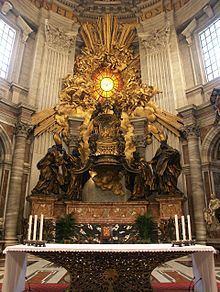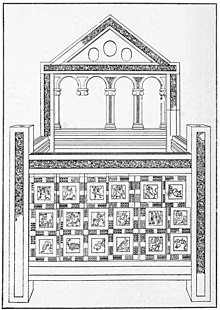Chair of Saint Peter
| Chair of Saint Peter | |
|---|---|
| Latin:Cathedra Petri | |
 | |
| Artist | Gian Lorenzo Bernini |
| Year | 1657–1666 |
| Catalogue | 61 |
| Type | Sculpture |
| Medium | Giltbronze |
| Location | St. Peter's Basilica,Vatican City |
| 41°54′8″N12°27′12″E/ 41.90222°N 12.45333°E | |
| Preceded by | Habakkuk and the Angel (Bernini) |
| Followed by | Saints Jerome and Mary Magdalen (Bernini) |

TheChair of Saint Peter(Latin:Cathedra Petri), also known as theThrone of Saint Peter,is arelicconserved inSt. Peter's BasilicainVatican City,the sovereign enclave of thePopeinside Rome, Italy. The relic is a woodenthronethat tradition claims belonged to the ApostleSaint Peter,the leader of theEarly Christiansin Rome and firstPope,and which he used asBishop of Rome.[1]The relic is enclosed in a sculptedgiltbronzecasing designed byGian Lorenzo Berniniand constructed between 1647 and 1653.[1]In 2012,Pope Benedict XVIdescribed the chair as "a symbol of the special mission of Peter and his Successors to tend Christ's flock, keeping it united in faith and in charity."[2]
The wooden throne was a gift fromEmperor of the RomansCharles the BaldtoPope John VIIIin 875.[1]It has been studied many times over the years, most recently between 1968 and 1974, when it was last removed from the Bernini altar.[3]The study concluded that it was not a double, but a single chair, with a covering, and that the oldest parts are from the 6th century.[3]The Chair of Saint Peter is the second altar within the church with the first one being the one underthe baldacchino.It stands to remind visitors of the Catholic Church's authority.[4]
Description
[edit]The relic itself is described as an oaken chair damaged by cuts and worms. The chair has metal rings attached to each side, allowing use as asedia gestatoria.The back and front of the chair are trimmed with carved ivory. This description comes from 1867, when the relic was photographed and displayed for veneration.[5]
Thereliquary,like many of the medieval period, takes the form of the relic it protects, i.e. the form of a chair. Symbolically, the chair Bernini designed had no earthly counterpart in actual contemporary furnishings. It is formed entirely of scrolling members, enclosing a coved panel where the upholstery pattern is rendered as a low relief ofChristinstructing Peter to tend to his sheep.[6]Largeangelicfigures flank an openwork panel beneath a highly realistic bronze seat cushion, vividly empty: the relic is encased within.[a]
The cathedra is lofted on splayed scrolling bars that appear to be effortlessly supported by four over-lifesize bronzeDoctors of the Church:Western doctors SaintAmbroseand SaintAugustine of Hippoon the outsides, wearing miters, and Eastern doctors SaintJohn Chrysostomand SaintAthanasiuson the insides, both bare-headed. The cathedra appears to hover over the altar in the basilica's apse, lit by a central tinted window through which light streams, illuminating the gilded glory of sunrays and sculpted clouds that surrounds the window. Like Bernini'sEcstasy of Saint Theresa,this is a definitive fusion[7]of theBaroquearts, unifying sculpture and richly polychrome architecture and manipulating effects of light.
Above, on the golden background of the frieze, is the Latin inscription:"O Pastor Ecclesiae, tu omnes Christi pascis agnos et oves"('O Shepherd of the Church, you feed all Christ's lambs and sheep'). On the right is the same writing in Greek,"ΣΥ ΒΟΣΚΕΙΣ ΤΑ ΑΡΝΙΑ, ΣΥ ΠΟΙΜΑΙΝΕΙΣ ΤΑ ΠΡΟΒΑΤΙΑ ΧΡΙΣΤΟΥ".[8]Behind the altar is placed Bernini's monument enclosing the wooden chair, both of which are seen as symbolic of the authority of theBishop of RomeasVicar of Christand successor of Saint Peter.
Feast of the Chair of Saint Peter
[edit]Earlymartyrologiesindicate that two liturgical feasts were celebrated in Rome, centuries before the time of Charles the Bald, in honour of earlier chairs associated with Saint Peter, one of which was kept in the baptismal chapel of Old St. Peter's Basilica, the other at thecatacomb of Priscilla.[5]The dates of these celebrations were January 18 and February 22. No surviving chair has been identified with either of these chairs. The feasts thus became associated with an abstract understanding of the "Chair of Peter", which bysynecdochesignifies theepiscopal officeof thePopeasBishop of Rome,an office considered to have been first held bySaint Peter,and thus extended to the diocese, theSee of Rome.[9]
According to historianAnton de Waal,although both feasts were originally associated with Saint Peter's stay in Rome, the ninth-century form of theMartyrologium Hieronymianumassociated the January 18 feast with his stay in Rome, and the February 22 feast with his stay atAntioch.[5]The two feasts were included in theTridentine calendarwith therank of Double,whichPope Clement VIIIraised in 1604 to the newly invented rank of Greater Double.
In 1960Pope John XXIIIdeleted the January 18 feast from theGeneral Roman Calendar,along with seven other feast days that were duplicate feasts of a single saint or mystery. The February 22 celebration became aSecond-Class Feast.This calendar was incorporated in the1962 Roman MissalofPope John XXIII,whose continued usePope Benedict XVIauthorized under the conditions indicated in hismotu proprioSummorum Pontificum.Traditionalist Catholicswho use older calendars continue to celebrate both feast days: Saint Peter's Chair at Rome on January 18 and the Chair of Saint Peter at Antioch on February 22.
In the new classification of holy days introduced in 1969, the February 22 celebration has therank of Feast.
See also
[edit]Notes
[edit]- ^In late 17th-century Venice,Andrea Brustolonconstructed a few grandiose armchairs that employ similar sculptural figures doing duty as front legs and armrest supports.
References
[edit]- ^abc"Interior of the Basilica".Vatican State.Archived fromthe originalon 16 May 2017.Retrieved20 March2013.
- ^Akin, Jimmy (February 20, 2013)."9 things you need to know about the" Chair of St. Peter "".National Catholic Register.Retrieved23 March2016.
- ^ab"The Chair of Peter".Catholic Exchange.Sophia Institute Press. February 22, 2016.Retrieved23 March2016.
- ^"Gian Lorenzo Bernini, Cathedra Petri (Chair of St. Peter) – Smarthistory".smarthistory.org.Retrieved2023-02-23.
- ^abcWaal, Anton de. "Chair of Peter." The Catholic EncyclopediaVol. 3. New York: Robert Appleton Company, 1908
 This article incorporates text from this source, which is in thepublic domain.
This article incorporates text from this source, which is in thepublic domain.
- ^John 21:17
- ^SeeGesamtkunstwerk
- ^"The Tribune: Altar of the Chair of St. Peter".Retrieved14 September2014.
- ^"Chair of Saint Peter", Franciscan Media
![]() This article incorporates text from a publication now in thepublic domain:Herbermann, Charles, ed. (1913). "Chair of Peter".Catholic Encyclopedia.New York: Robert Appleton Company.
This article incorporates text from a publication now in thepublic domain:Herbermann, Charles, ed. (1913). "Chair of Peter".Catholic Encyclopedia.New York: Robert Appleton Company.
External links
[edit]| External videos | |
|---|---|
 Media related toCathedra Petriat Wikimedia Commons
Media related toCathedra Petriat Wikimedia Commons- Altar of the Chair of St. Peter
- Catholic Encyclopedia:"Chair of St. Peter"— article contains photograph of the chair of Charles the Bald
- Encyclopædia BritannicaOnline: Gian Lorenzo Bernini
- "Masaryk University"
